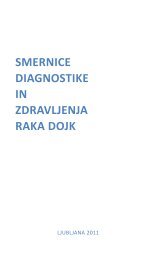Create successful ePaper yourself
Turn your PDF publications into a flip-book with our unique Google optimized e-Paper software.
Antiproliferative and adhesion-stimulating effects on human cancer cell<br />
lines elicited by lectins from mushroom Clitocybe nebularis<br />
Jure Pohleven1 ,2, Nataša Obermajer2, Jerica Sabotič1, Bogdan Kralj3, Janko Kos2, Borut<br />
Štrukelj1 ,2, Jože Brzin1<br />
1Dept. <strong>of</strong> Biotechnology, Jožef Stefan Institute, Jamova 39, SI-1000 Ljubljana, Slovenia; 2Dept. <strong>of</strong><br />
Pharmaceutical Biology, Faculty <strong>of</strong> Pharmacy, University <strong>of</strong> Ljubljana, Aškerčeva 7, SI-1000 Ljubljana,<br />
Slovenia; 3Mass Spectrometry Centre, Dept. <strong>of</strong> Environmental Chemistry, Jožef Stefan Institute, Jamova<br />
39, SI-1000 Ljubljana, Slovenia<br />
Fungi are well known for their medicinal values and numerous bioactive compounds with<br />
pharmacological properties have been isolated from mushrooms. Lectins are a diverse<br />
and ubiquitous group <strong>of</strong> non-homologous proteins that specifically bind different types<br />
<strong>of</strong> carbohydrates. Most lectins are multivalent, containing more than one carbohydratebinding<br />
site; therefore they can cross-link cell surface carbohydrates and agglutinate cells.<br />
Their biological activity is exerted through binding to glycoconjugates on cell surfaces,<br />
extracellular matrix and cytoplasmic or nuclear glycoproteins. Lectins elicit a variety <strong>of</strong><br />
effects in different organisms and are suggested to have many biological functions which<br />
are still not fully understood.<br />
In this study, several lectins were isolated from fruiting bodies <strong>of</strong> mycorrhizal basidiomycete<br />
fungus Clouded agaric (Clitocybe nebularis) by affinity chromatography using carbohydrates<br />
(glucose, galactose, sucrose, lactose) as ligands. Lectins were purified using HPLC and<br />
their molecular masses were determined by mass spectrometry. They were shown to<br />
be oligomeric by gel filtration and native gel electrophoresis. Hemagglutination and<br />
hemagglutination inhibition assays with human type A, B, 0, AB and bovine erythrocytes<br />
were performed to determine lectins specificity and they were shown to be pH and heat<br />
stable. Their N-terminal and internal amino acid sequences were determined by protein<br />
sequencing and degenerative PCR primers were designed to obtain genomic and cDNA<br />
p38<br />
nucleotide sequences using genome walking and reverse-transcription PCR as well as<br />
rapid amplification <strong>of</strong> cDNA ends methods. Deduced amino acid sequence was compared<br />
to protein sequences in databases. Effects on proliferation and adhesion were studied on<br />
human breast epithelial tumour cell line (MCF-10A NeoT), human T leukaemia cell<br />
line (Mo-T), differentiated and undifferentiated human monocytic lymphoma cell line<br />
(U-937).<br />
From among isolated proteins, lactose-specific and galactose-specific lectins showed the<br />
most potent effects on human cancer cell lines. Galactose-specific lectins stimulated plastic<br />
adherence <strong>of</strong> differentiated U-937 cells, suggesting that they interact with integrins and<br />
activate integrin-mediated adhesion. Lactose-specific lectin exerted antiproliferative effect<br />
on human T leukaemia cell line. This lectin has a potential use in treating haematopoietic<br />
malignances so complete genomic and cDNA sequences were obtained. The gene consists<br />
<strong>of</strong> five exons and four introns. Comparing a deduced amino acid sequence to protein<br />
databases using BLASTP, SMART and Pfam tools revealed that lactose-specific lectin<br />
belongs to a ricin B-like lectin protein family.<br />
120
















